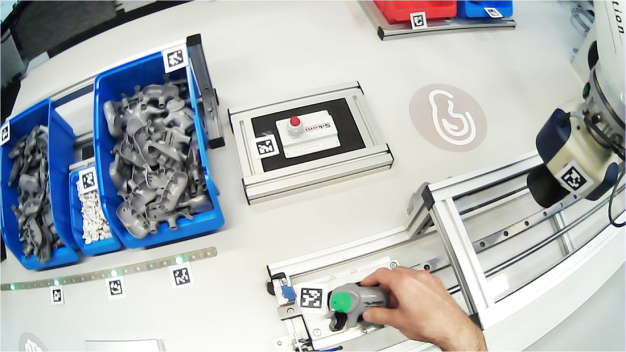- R+D & Community of Interest
Employee-focused workplaces increase productivity
In order to design assembly workplaces in a more employee-focused manner, a researcher from the Fraunhofer Institute for Manufacturing Engineering and Automation IPA has not only determined the requirements of people, but also evaluated machine data. With this approach, the researcher’s aim is to increase the efficiency, effectiveness and satisfaction of employees.
Every developer of assembly workstations has different ideas of the target group and sets different priorities. Time and again, this leads to misunderstandings within the team. »Products are improved and workbenches and other assembly workstations remain serviceable for longer when the designer knows exactly what the target group needs and takes it into account in the design«, says Saskia Wiedenroth from the Image and Signal Processing department at Fraunhofer IPA. Otherwise, features may be developed that the user ultimately does not need.
In order to avoid such undesirable developments and shorten development times, it is advisable to collect and evaluate user data. Thus, there are a number of issues to be resolved, such as what result are technicians aiming for at the end of the day? At which points do errors most frequently occur? How can the machine software be made more intuitive? Saskia Wiedenroth is working on clarifying these and other issues as part of the »Data Driven User Needs Assessments« (D²UNA) research project, which is supported by the Future Work Lab.
Eye-tracking systems reveal eye tracking at work
In order to determine the requirements, Saskia Wiedenroth goes on site at the factory with a sensor case. This contains, among other items, eye-tracking systems, screens, cameras, sound recording devices and QR codes. She uses the cameras to record where the fitter intervenes manually and which tools he uses. While Saskia Wiedenroth records every step of the work process, the fitters gives a running commentary on what they are doing. The eye-tracking systems reveal which areas of the workplace fitters look at for longer, which they only glance at and which they do not observe at all. The QR codes correspond to the eye-tracking systems and show line of sight correlations.
At the same time, researcher Wiedenroth records the machine data via individually developed interfaces. Using Blickshift analysis software, she links the machine data with the user data. »This shows, for example, that after twelve seconds, the welding machine is put into operation and at the same time, the robot arm moves without the technician noticing,« she explains. Saskia Wiedenroth then analyzes such occurrences and uses them to create an index of how serious the shortcomings discovered are.
Saving time and costs during training
Finally, a heat map is created from all the data collected plus the index, i.e. a representation of the entire workplace with a chronological sequence of every work step and the potential error locations. »I can see from this that at a certain point, an error occurs, but the fitter does not even notice it because at the time, he is distracted at another point,« says Wiedenroth. Based on the results of the analysis, she creates a report from which she derives optimization measures and a worker profile. These profiles allow developers to design workplaces in a more targeted and user-oriented manner.
Workplace optimization, which the developers can carry out with the aid of Saskia Wiedenroth’s analyses, not only increases assembly-line productivity, but also saves time and costs when training new fitters. The foremen are relieved of the burden of training and the new employees work more quickly and productively.
User analysis as a service
Saskia Wiedenroth plans to offer the user analysis as a service in the future in order to further refine its methodology. To this end, it is looking for industrial partners who have recognized the importance of user centricity and who wish to design their assembly workstations more individually.
![]()
Fraunhofer-Institut für Produktionstechnik und Automatisierung IPA
Nobelstraße 12
70569 Stuttgart
Germany
Phone: +49 711 970 1667
email: joerg-dieter.walz@ipa.fraunhofer.de
Internet: http://www.ipa.fraunhofer.de









